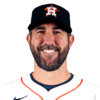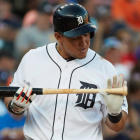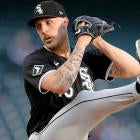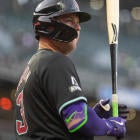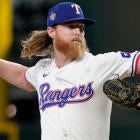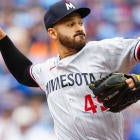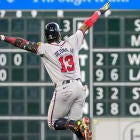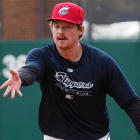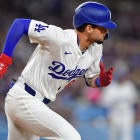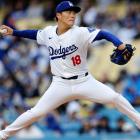Looks like we've reached our breaking point with Carlos Gonzalez.
His ownership rate in CBS Sports leagues has taken its biggest hit over the last week, dropping to 82 percent, and I recently said on the Fantasy Baseball Today podcast that I'd be comfortable dropping him in three-outfielder leagues.
It's not just because of performance. In fact, Gonzalez has a history of underperforming for entire half-seasons. What makes him Fantasy royalty is that he always bounces back.
But when the Rockies themselves lose faith, sitting him in favor of Gerardo Parra and Ian Desmond, as they've done recently, it's time to reevaluate. And considering this year's outfield landscape, as well as the additional hurdle (a return to everyday duty) he'll have to clear to regain top standing, many of us have assessed we can live without Gonzalez.
Of course, dropping a player is the most extreme course of action. For most players of Gonzalez's stature, our frustration won't ever rise to that point. But we may come to accept diminished production as the new expectation. Such was the inspiration for last month's Enough Is Enough column, wherein I identified 12 players, Gonzalez included, whose production we shouldn't necessarily expect to improve.
I regret nothing.
But what about the other side of the coin? Nearly two-thirds of the way into the 2017, shouldn't we be taking every player's numbers at face value, regardless of how we felt coming into the season?
Ah, but regression works in mysterious ways. Time helps, but there is no definite window in which correction occurs. For these 12, I still see reason for optimism.
That's right: You haven't missed your chance to buy low.
Miguel Cabrera
Detroit 1B
|
| It just feels wrong to see Miguel Cabrera, the rock upon which so many Fantasy owners have built their teams for the last decade-plus, with such ordinary numbers, and judging by the batted-ball data, it is wrong. According to FanGraphs, his line-drive and hard-contact rates are both the best of his illustrious career (ranking second and third in the majors, respectively), so the fact he has a .297 BABIP (instead of his usual .350 mark) is outrageous. It's possible he's playing through something, given his injury history -- and there was some mention of a hip issue just before the All-Star break -- but then, why would the quality of the contact be so great? |
Matt Carpenter
St. Louis 1B
|
| As with Cabrera, the BABIP suggests bad luck for Matt Carpenter, residing about 50 points below his career mark. Of course, he does have a career-high fly-ball rate, which invites a lower BABIP, but his 24.1 percent line-drive rate (23rd-highest in the majors) should partly counteract it. And actually, the elevated fly-ball rate, when combined with a career-high hard-contact rate, should work to Carpenter's advantage, giving him an easier path to his power gains from the last two years. He remains an exceptionally disciplined hitter, reaching base at a .384 clip, so as long as he keeps making quality contact, he could get back to being an MVP-caliber player. |

Johnny Cueto
San Francisco SP
|
| Johnny Cueto is on the DL now, sitting out with a blister issue that has plagued him since May, and ... that about sums it up, doesn't it? You can't expect him to manipulate pitches the same way if he doesn't normal feeling in his fingers, which he finally admitted after his last start. Before the rocky three-start stretch that forced him to concede, his numbers weren't so bad. Three or four earned runs over six or seven innings will inflate an ERA, but in this environment, you'll take a pitcher who consistently goes so deep into games while averaging about a strikeout per inning. I expect to see closer to last year's Cueto after a couple weeks' rest. |
Marco Estrada
Toronto SP
|
| Marco Estrada's numbers over his last eight starts -- a 9.50 ERA and 2.17 WHIP -- may be more a reflection of his boom-or-bust nature than his skill level. He looked like a Cy Young candidate over his first 11 starts, remember, compiling a 3.15 ERA, 1.11 WHIP and 10.2 strikeouts per nine innings, but there's a reason pitchers who sit in the high 80s generally don't miss so many bats. Estrada's success has always depended on uncommon command, and when he's just a little off, he gets pounded. He's more than a little off right now, as evidenced by his 8.9 walks per nine innings over his last five starts, but he could turn it around just as abruptly. |
Todd Frazier
N.Y. Yankees 3B
|
| Clearly, the Yankees agree with me, having acquired Todd Frazier to take over as their everyday third baseman, but because his struggles are part of a two-year trend, many of my analyst cohorts are skeptical he has anything left in the tank. True, fly-ball hitters like him are predisposed to low BABIPs, but more like the .270 marks we saw during his studly years in Cincinnati than the .236 and .214 marks we've seen the last two years. It's not like his power has been compromised. He actually set a career high with 40 homers last year, and his improved strikeout and walk rates suggest his bat isn't slowing down. |
Ian Kinsler
Detroit 2B
|
| Like with Frazier, I'd expect to see more swing-and-miss in Ian Kinsler's game if he was going the old man route -- and I did see it last year, which is why he was one of my preseason bust picks. But even though his production this year would seem to validate my prediction, he has gotten back to making contact like he did early in his career. No, the culprit is -- surprise, surprise -- a low BABIP, which probably has a little something to do with his inflated fly-ball rate, but he also has a career-best hard-contact rate. As I said with Carpenter, the two in conjunction should be a good thing. |
Manny Machado
Baltimore 3B
|
| Let's see ... Manny Machado is striking out and walking at his usual rates, hitting the ball as hard as ever and yet suffering from a .254 BABIP. Same story, different name. Machado does have the added wrinkle of a dreadful line-drive rate, ranking seventh-lowest among qualifiers, but his is never particularly high. And when you consider the fact he's a 25-year-old heretofore considered a transcendent talent, I have to think it's more of a symptom than a cause, especially considering the other data. There's a reason my first piece of advice to those who lost Trea Turner and Carlos Correa was to trade for Machado: He's about to come roaring back. |
Rougned Odor
Texas 2B
|
| I'll grant this much to the Rougned Odor skeptics out there: He's popping out way more than he did last year. It's the most useless form of contact and helps explain his .240 BABIP this year. But it only helps explain it, and as with Machado's low line-drive rate, I wouldn't presume it's the new normal. Odor bounced back from a similar mark two years ago, when by the way, he had a pretty good season. Otherwise, his story is about the same as these other hitters'. His strikeout rate is up a little and the quality of his contact down a little, but nothing that should derail a 23-year-old thought to be on the upswing. |
Carlos Santana
Cleveland 1B
|
| At least in points leagues, Carlos Santana hasn't actually been bad. His high walk rate makes him virtually foolproof in that format, and never has it been more evident than this year, with him outscoring up-and-comers like Justin Bour, Yonder Alonso and Marwin Gonzalez. But he could be even better, and Rotisserie owners especially would like him to be. Bad news: The biggest change from a year ago is that he isn't elevating the ball as much, costing him home runs. Good news: Those missing fly balls have taken the form line drives. So even though his BABIP is about the same as last year, he has suffered from bad luck, and I predict his power normalizes in the second half, too. |
Trevor Story
Colorado SS
|
| You won't find much reason for optimism in the underlying numbers. On the rare occasion Trevor Story has made contact this year, it hasn't been of a particularly high quality. He has been, without question, a bad hitter. But I have a hard time believing a player with his raw power will stay bad at Coors Field. It's just too much of a safety net. Pitches are flatter. Hits travel farther. BABIPs swell to unprecedented heights. It's no secret that players with as much swing-and-miss in their game as Story endure lengthy cold stretches, and I firmly believe low-quality contact -- just missing even when they "connect" -- is a logical side effect. Plus, he's a shortstop, so hope springs eternal. |
Mark Trumbo
Baltimore DH
|
| Mark Trumbo is like Frazier lite, showing improvement in areas that normally reflect growth -- strikeout and walk rate -- but struggling to do the things that matter most. The struggle hasn't been as bad -- he has been a usable outfielder in Fantasy this year -- but after leading the majors with 47 homers last year, his 15 to this point are a major letdown. Understand, though, that last year wasn't an aberration: He had a three-year run with the Angels as one of the top home run hitters in the game (back when everyone was hitting about seven home runs fewer). If he's missing, he's just missing, and his true talent will reveal itself in the long run. |
Justin Verlander
Detroit SP
|
| The idea that Justin Verlander is washed up, as many suggest whenever he's mentioned in trade rumors, is ridiculous. He throws 99 mph and is coming off one of the best half-seasons in MLB history, nearly wrestling away the AL Cy Young award with a 1.96 ERA, 0.86 WHIP and 10.9 strikeouts per nine innings across 16 starts. I don't know exactly what's wrong, but I know that's not it. He is getting hit hard and issuing walks at an unusually high rate, so something has compromised his command. If it's an unreported injury, he may continue to struggle, but if it's wayward mechanics, he's just a tweak away from going on a similar run. |

















